Neurochemical Theories of Schizophrenia and the Mechanism of Action of Haloperidol and Clozapine
VerifiedAdded on 2023/03/31
|11
|2461
|364
AI Summary
This essay discusses the neurochemical theories of schizophrenia, including the dopamine theory, glutamate theory, and serotonin theory. It also explores the mechanism of action of two drugs used to treat schizophrenia, Haloperidol and Clozapine.
Contribute Materials
Your contribution can guide someone’s learning journey. Share your
documents today.
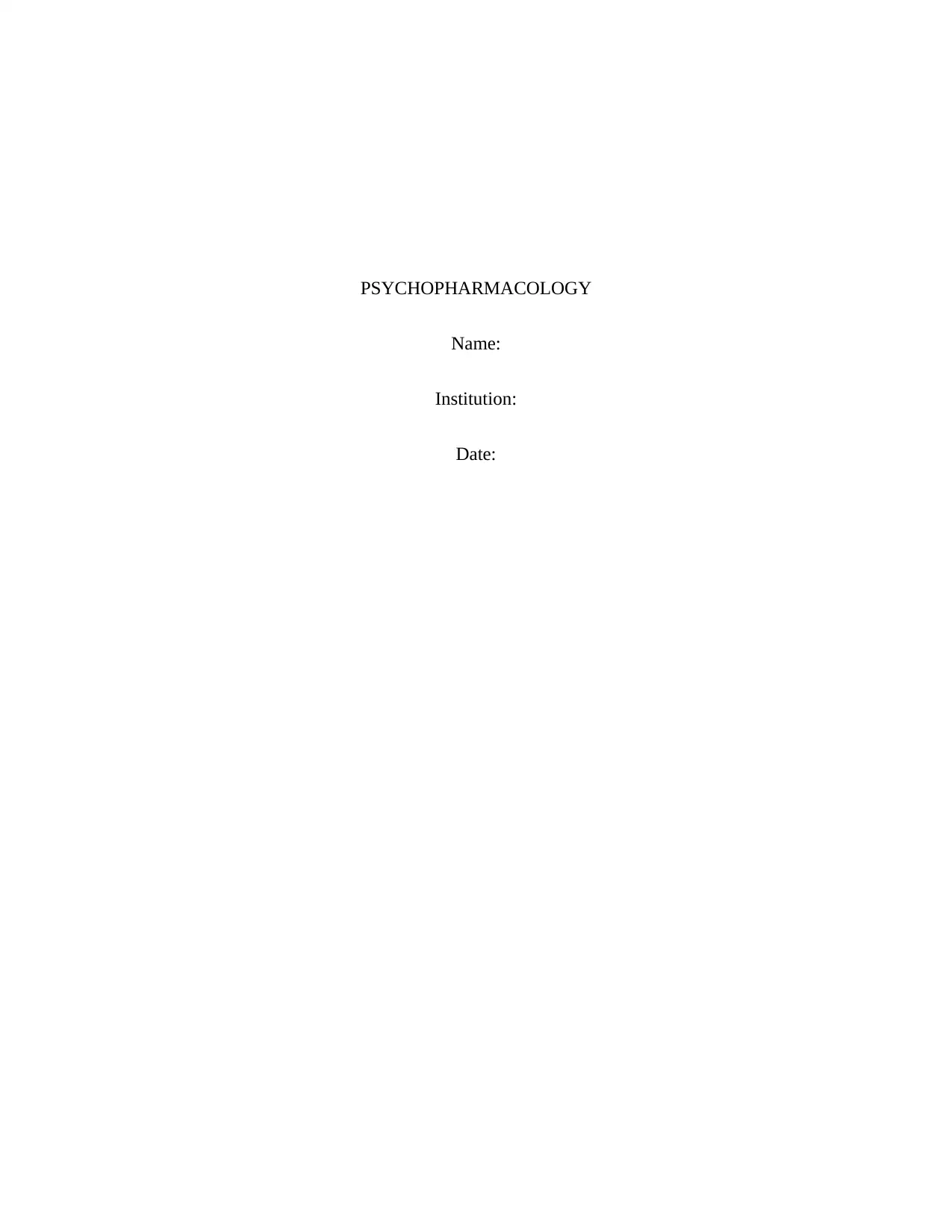
PSYCHOPHARMACOLOGY
Name:
Institution:
Date:
Name:
Institution:
Date:
Secure Best Marks with AI Grader
Need help grading? Try our AI Grader for instant feedback on your assignments.
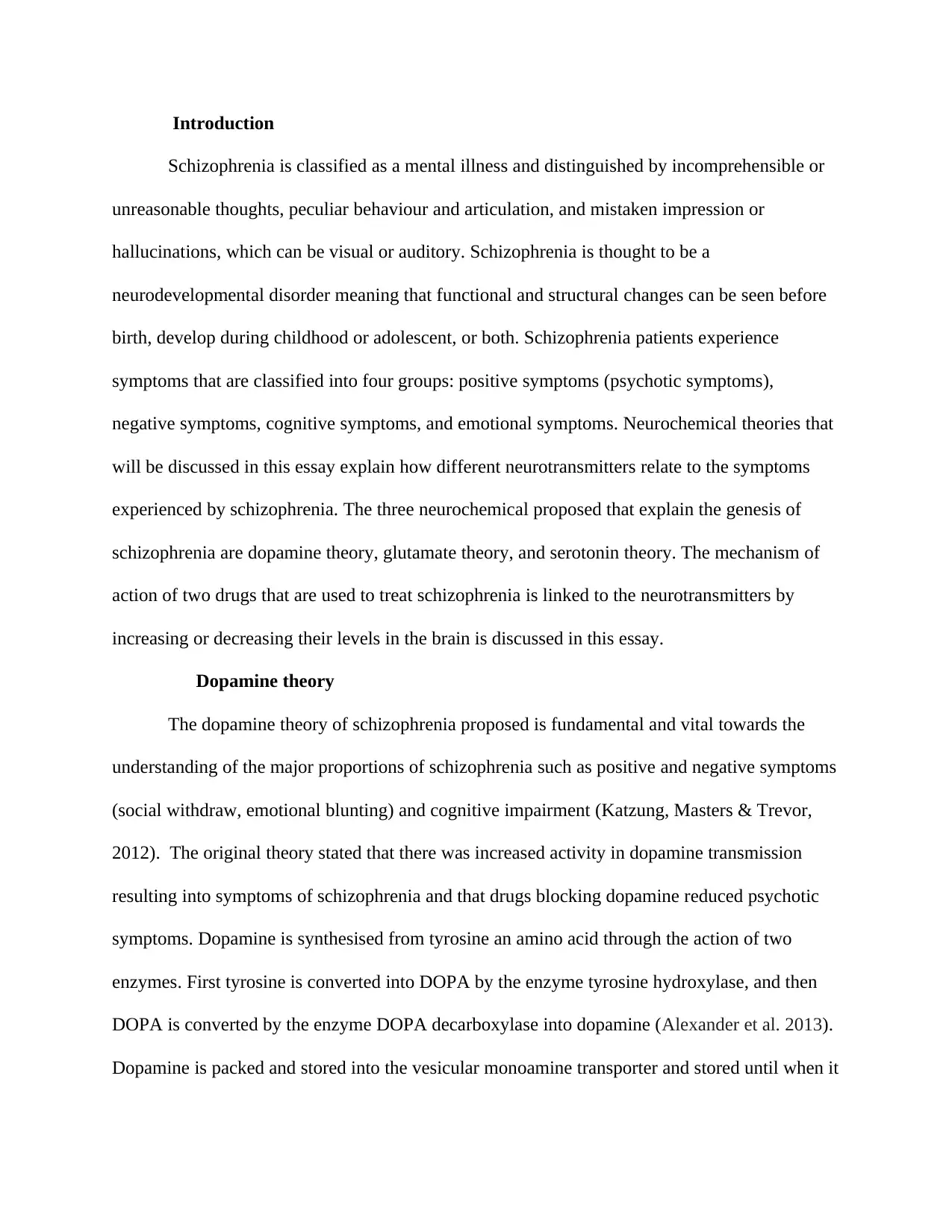
Introduction
Schizophrenia is classified as a mental illness and distinguished by incomprehensible or
unreasonable thoughts, peculiar behaviour and articulation, and mistaken impression or
hallucinations, which can be visual or auditory. Schizophrenia is thought to be a
neurodevelopmental disorder meaning that functional and structural changes can be seen before
birth, develop during childhood or adolescent, or both. Schizophrenia patients experience
symptoms that are classified into four groups: positive symptoms (psychotic symptoms),
negative symptoms, cognitive symptoms, and emotional symptoms. Neurochemical theories that
will be discussed in this essay explain how different neurotransmitters relate to the symptoms
experienced by schizophrenia. The three neurochemical proposed that explain the genesis of
schizophrenia are dopamine theory, glutamate theory, and serotonin theory. The mechanism of
action of two drugs that are used to treat schizophrenia is linked to the neurotransmitters by
increasing or decreasing their levels in the brain is discussed in this essay.
Dopamine theory
The dopamine theory of schizophrenia proposed is fundamental and vital towards the
understanding of the major proportions of schizophrenia such as positive and negative symptoms
(social withdraw, emotional blunting) and cognitive impairment (Katzung, Masters & Trevor,
2012). The original theory stated that there was increased activity in dopamine transmission
resulting into symptoms of schizophrenia and that drugs blocking dopamine reduced psychotic
symptoms. Dopamine is synthesised from tyrosine an amino acid through the action of two
enzymes. First tyrosine is converted into DOPA by the enzyme tyrosine hydroxylase, and then
DOPA is converted by the enzyme DOPA decarboxylase into dopamine (Alexander et al. 2013).
Dopamine is packed and stored into the vesicular monoamine transporter and stored until when it
Schizophrenia is classified as a mental illness and distinguished by incomprehensible or
unreasonable thoughts, peculiar behaviour and articulation, and mistaken impression or
hallucinations, which can be visual or auditory. Schizophrenia is thought to be a
neurodevelopmental disorder meaning that functional and structural changes can be seen before
birth, develop during childhood or adolescent, or both. Schizophrenia patients experience
symptoms that are classified into four groups: positive symptoms (psychotic symptoms),
negative symptoms, cognitive symptoms, and emotional symptoms. Neurochemical theories that
will be discussed in this essay explain how different neurotransmitters relate to the symptoms
experienced by schizophrenia. The three neurochemical proposed that explain the genesis of
schizophrenia are dopamine theory, glutamate theory, and serotonin theory. The mechanism of
action of two drugs that are used to treat schizophrenia is linked to the neurotransmitters by
increasing or decreasing their levels in the brain is discussed in this essay.
Dopamine theory
The dopamine theory of schizophrenia proposed is fundamental and vital towards the
understanding of the major proportions of schizophrenia such as positive and negative symptoms
(social withdraw, emotional blunting) and cognitive impairment (Katzung, Masters & Trevor,
2012). The original theory stated that there was increased activity in dopamine transmission
resulting into symptoms of schizophrenia and that drugs blocking dopamine reduced psychotic
symptoms. Dopamine is synthesised from tyrosine an amino acid through the action of two
enzymes. First tyrosine is converted into DOPA by the enzyme tyrosine hydroxylase, and then
DOPA is converted by the enzyme DOPA decarboxylase into dopamine (Alexander et al. 2013).
Dopamine is packed and stored into the vesicular monoamine transporter and stored until when it

is released into the synapse. The step requiring tyrosine hydroxylase is the rate rate-limiting step
in the production of dopamine, and it is found to be increased significantly in patients with
schizophrenia compared to normal individuals. Dopamine plays several pivotal roles in emotion,
movement, and cognition as a chemical in the brain (Schneider et al. 2017).
Evidence suggests increased dopamine activity in the brain results in aggravated
psychosis of schizophrenia or produces in some patient’s psychosis through the de novo process..
The observations that form the cornerstone of this theory is that drugs which block the D2
receptors lower the symptoms of psychosis and agonists of dopamine worsen the symptoms
(Gross, Wicke & Drescher, 2013). The density of dopamine receptors has been found to be
elevated in the brain of schizophrenic patients who were not using drugs recommended for
schizophrenia. Drugs that mediate blockage of neural storage of dopamine and dopamine
antagonists are useful in the management of the positive symptoms seen in patients with
schizophrenia. The theory further suggests that negative and cognitive symptoms present in
schizophrenic patients can be linked to lower functioning of the dopamine receptor (D1)
prefrontal cortex neurotransmission. In recent studies that have been done, there is reported
increased presynaptic synthesis capacity in patients with schizophrenia. Evidence also shows that
if synthesis of dopamine is elevated and in the face of challenges it is more sensitive to release, it
is expected that dopamine levels would be increased when the patients are psychotic (Howes et
al. 2017).
Glutamate theory
There are several excitatory neurotransmitters of the glutamate is the major one and acts
on ionotropic N-methyl-D-aspartate (NMDA) receptors in the brain of normal human beings.
The glutamate theory is based on the fact that by administering non-competitive antagonists to
in the production of dopamine, and it is found to be increased significantly in patients with
schizophrenia compared to normal individuals. Dopamine plays several pivotal roles in emotion,
movement, and cognition as a chemical in the brain (Schneider et al. 2017).
Evidence suggests increased dopamine activity in the brain results in aggravated
psychosis of schizophrenia or produces in some patient’s psychosis through the de novo process..
The observations that form the cornerstone of this theory is that drugs which block the D2
receptors lower the symptoms of psychosis and agonists of dopamine worsen the symptoms
(Gross, Wicke & Drescher, 2013). The density of dopamine receptors has been found to be
elevated in the brain of schizophrenic patients who were not using drugs recommended for
schizophrenia. Drugs that mediate blockage of neural storage of dopamine and dopamine
antagonists are useful in the management of the positive symptoms seen in patients with
schizophrenia. The theory further suggests that negative and cognitive symptoms present in
schizophrenic patients can be linked to lower functioning of the dopamine receptor (D1)
prefrontal cortex neurotransmission. In recent studies that have been done, there is reported
increased presynaptic synthesis capacity in patients with schizophrenia. Evidence also shows that
if synthesis of dopamine is elevated and in the face of challenges it is more sensitive to release, it
is expected that dopamine levels would be increased when the patients are psychotic (Howes et
al. 2017).
Glutamate theory
There are several excitatory neurotransmitters of the glutamate is the major one and acts
on ionotropic N-methyl-D-aspartate (NMDA) receptors in the brain of normal human beings.
The glutamate theory is based on the fact that by administering non-competitive antagonists to
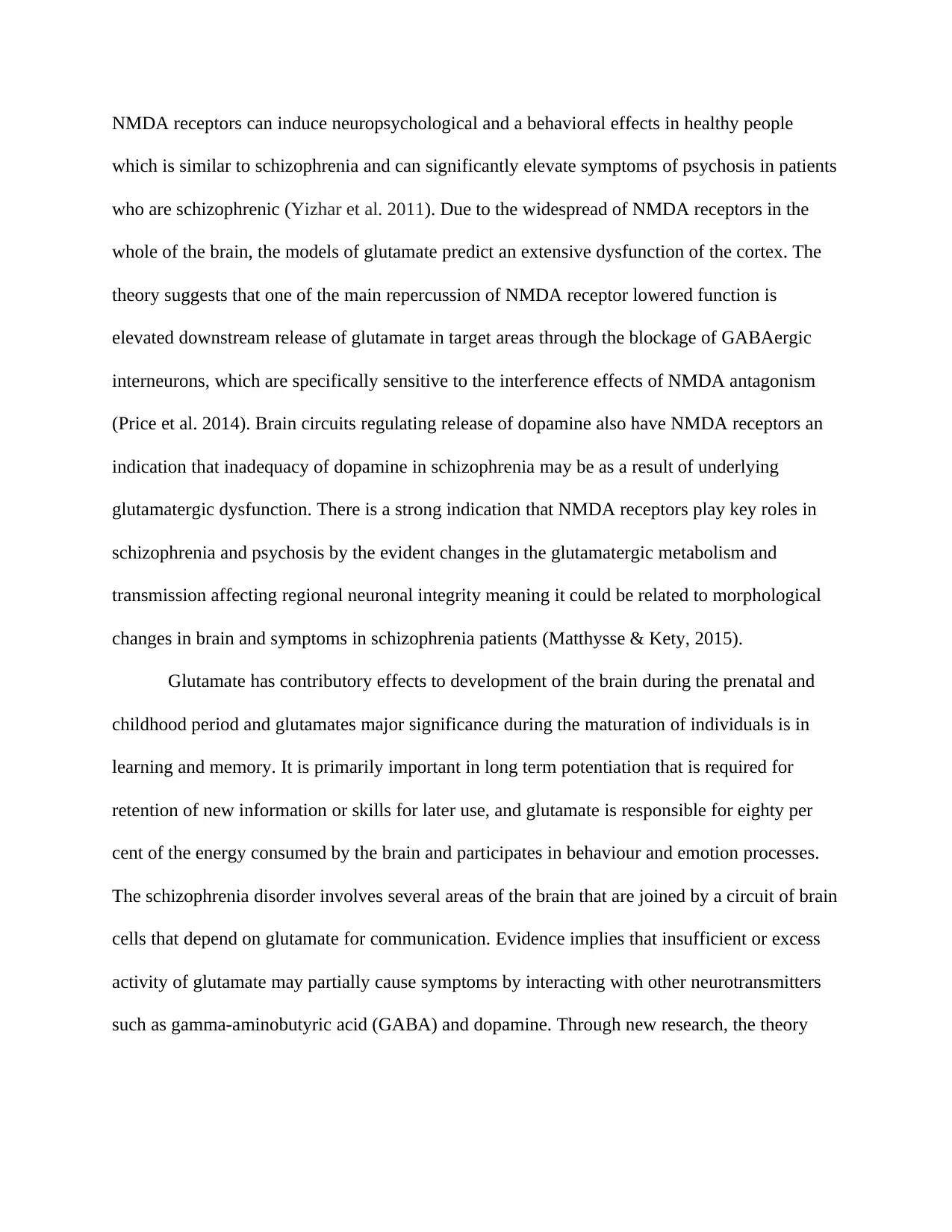
NMDA receptors can induce neuropsychological and a behavioral effects in healthy people
which is similar to schizophrenia and can significantly elevate symptoms of psychosis in patients
who are schizophrenic (Yizhar et al. 2011). Due to the widespread of NMDA receptors in the
whole of the brain, the models of glutamate predict an extensive dysfunction of the cortex. The
theory suggests that one of the main repercussion of NMDA receptor lowered function is
elevated downstream release of glutamate in target areas through the blockage of GABAergic
interneurons, which are specifically sensitive to the interference effects of NMDA antagonism
(Price et al. 2014). Brain circuits regulating release of dopamine also have NMDA receptors an
indication that inadequacy of dopamine in schizophrenia may be as a result of underlying
glutamatergic dysfunction. There is a strong indication that NMDA receptors play key roles in
schizophrenia and psychosis by the evident changes in the glutamatergic metabolism and
transmission affecting regional neuronal integrity meaning it could be related to morphological
changes in brain and symptoms in schizophrenia patients (Matthysse & Kety, 2015).
Glutamate has contributory effects to development of the brain during the prenatal and
childhood period and glutamates major significance during the maturation of individuals is in
learning and memory. It is primarily important in long term potentiation that is required for
retention of new information or skills for later use, and glutamate is responsible for eighty per
cent of the energy consumed by the brain and participates in behaviour and emotion processes.
The schizophrenia disorder involves several areas of the brain that are joined by a circuit of brain
cells that depend on glutamate for communication. Evidence implies that insufficient or excess
activity of glutamate may partially cause symptoms by interacting with other neurotransmitters
such as gamma-aminobutyric acid (GABA) and dopamine. Through new research, the theory
which is similar to schizophrenia and can significantly elevate symptoms of psychosis in patients
who are schizophrenic (Yizhar et al. 2011). Due to the widespread of NMDA receptors in the
whole of the brain, the models of glutamate predict an extensive dysfunction of the cortex. The
theory suggests that one of the main repercussion of NMDA receptor lowered function is
elevated downstream release of glutamate in target areas through the blockage of GABAergic
interneurons, which are specifically sensitive to the interference effects of NMDA antagonism
(Price et al. 2014). Brain circuits regulating release of dopamine also have NMDA receptors an
indication that inadequacy of dopamine in schizophrenia may be as a result of underlying
glutamatergic dysfunction. There is a strong indication that NMDA receptors play key roles in
schizophrenia and psychosis by the evident changes in the glutamatergic metabolism and
transmission affecting regional neuronal integrity meaning it could be related to morphological
changes in brain and symptoms in schizophrenia patients (Matthysse & Kety, 2015).
Glutamate has contributory effects to development of the brain during the prenatal and
childhood period and glutamates major significance during the maturation of individuals is in
learning and memory. It is primarily important in long term potentiation that is required for
retention of new information or skills for later use, and glutamate is responsible for eighty per
cent of the energy consumed by the brain and participates in behaviour and emotion processes.
The schizophrenia disorder involves several areas of the brain that are joined by a circuit of brain
cells that depend on glutamate for communication. Evidence implies that insufficient or excess
activity of glutamate may partially cause symptoms by interacting with other neurotransmitters
such as gamma-aminobutyric acid (GABA) and dopamine. Through new research, the theory
Secure Best Marks with AI Grader
Need help grading? Try our AI Grader for instant feedback on your assignments.

suggests that hypofunction of glutamate generates an increase in dopamine (Brandon & Sawa,
2011).
Serotonin theory
Serotonin is synthesised from the amino acid tryptophan, and it is used as a
neurotransmitter in the brain. Serotonin plays an integral part in physiological responses such as
circadian rhythm, feeding, and sexual behavior. It also has important roles in processes that
involve the brain like cognition and mood, and it is thought to be involved in schizophrenia.
Serotonin theory of schizophrenia was developed from the observations about the
pharmacological effects of drugs used for recreation and were hallucinogenic such as lysergic
acid diethylamide (LSD) (Schmid & Liechti, 2018). These drugs acted by blocking the effects of
serotonin at specific receptors and therefore it was reasoned that if they could produce these
changes in the brain and behaviour they may be the internal processes in the brains of patients
with schizophrenia were occurring and producing the symptoms of the disorder. Research has
found that serotonin receptor 5-HT2A receptor blockade is key to the treatment of schizophrenia,
indicating that understanding the effects of serotonin in the brain is important in this theory.
Serotonin is implicated in a variety of behaviours and somatic functions that are found in patients
with schizophrenia such as mood and sleep behaviour (Kondej, Stępnicki & Kaczor, 2018).
Research based on this theory has shown that 5HT1A receptors are increased in the frontal cortex,
thalamus, and hippocampus of patients with schizophrenia as compared to normal individuals.
Serotonin antagonists ameliorate the extrapyramidal effects of antipsychotics. Direct evidence of
serotonergic dysfunction in the genesis of schizophrenia symptoms is not yet available, but the
theory is of great interest in the understanding of the disorder (Waltes, Chiocchetti, & Freitag,
2016).
2011).
Serotonin theory
Serotonin is synthesised from the amino acid tryptophan, and it is used as a
neurotransmitter in the brain. Serotonin plays an integral part in physiological responses such as
circadian rhythm, feeding, and sexual behavior. It also has important roles in processes that
involve the brain like cognition and mood, and it is thought to be involved in schizophrenia.
Serotonin theory of schizophrenia was developed from the observations about the
pharmacological effects of drugs used for recreation and were hallucinogenic such as lysergic
acid diethylamide (LSD) (Schmid & Liechti, 2018). These drugs acted by blocking the effects of
serotonin at specific receptors and therefore it was reasoned that if they could produce these
changes in the brain and behaviour they may be the internal processes in the brains of patients
with schizophrenia were occurring and producing the symptoms of the disorder. Research has
found that serotonin receptor 5-HT2A receptor blockade is key to the treatment of schizophrenia,
indicating that understanding the effects of serotonin in the brain is important in this theory.
Serotonin is implicated in a variety of behaviours and somatic functions that are found in patients
with schizophrenia such as mood and sleep behaviour (Kondej, Stępnicki & Kaczor, 2018).
Research based on this theory has shown that 5HT1A receptors are increased in the frontal cortex,
thalamus, and hippocampus of patients with schizophrenia as compared to normal individuals.
Serotonin antagonists ameliorate the extrapyramidal effects of antipsychotics. Direct evidence of
serotonergic dysfunction in the genesis of schizophrenia symptoms is not yet available, but the
theory is of great interest in the understanding of the disorder (Waltes, Chiocchetti, & Freitag,
2016).

The drug Haloperidol
Haloperidol is a drug recommended for the treatment of schizophrenic patients, and it is
under the butyrophenone derivative chemical classification. The drug haloperidol interferes with
the dopamine effects and increases its turnover, but the actual mechanism of action is not wholly
understood (Zaslau, 2013). Hyperactivity of dopamine can either be presynaptic (dopamine
nerve terminals release dopamine in surplus) or postsynaptic (D2 receptors are increased in
density or post-receptor action is increased). Haloperidol attaches more firmly to dopamine D2
receptors than dopamine itself with separation constants that are underneath those of dopamine
(Newman-Tancredi & Kleven, 2011). Haloperidol is thought to act in the brain by competitively
blocking post-synaptic dopamine receptors, thereby doing away with the transmission of
dopamine and leading to relief of hallucinations and delusions, which are the symptoms mainly
related to psychosis. Haloperidol basically acts on the D2 receptors but also has variable effects
on alpha1and 5-HT2 receptors with minimal effects on D1 dopamine receptors. Optimal clinical
efficacy is associated with blockage of about sixty to eighty percent of D2 dopamine receptors in
the brain (Wang et al. 2018).
The dopamine theory of schizophrenia proposes that increased dopamine activity in the
brain results in the symptoms seen in patients, and this can be directly linked to haloperidol,
which blocks the receptors used by dopamine. The blockage of dopamine receptors by
haloperidol means that though dopamine levels are increased in the brain, it will not be possible
for it to exert its effect when the receptors are blocked. Evidence through the theory also
suggests that there is increased dopamine receptor density in the brain and haloperidol can block
these receptors, therefore, treating schizophrenia patients. Haloperidol also can be linked to
serotonin theory, which looks at 5-HT receptors used by serotonin in the brain to exert its effect.
Haloperidol is a drug recommended for the treatment of schizophrenic patients, and it is
under the butyrophenone derivative chemical classification. The drug haloperidol interferes with
the dopamine effects and increases its turnover, but the actual mechanism of action is not wholly
understood (Zaslau, 2013). Hyperactivity of dopamine can either be presynaptic (dopamine
nerve terminals release dopamine in surplus) or postsynaptic (D2 receptors are increased in
density or post-receptor action is increased). Haloperidol attaches more firmly to dopamine D2
receptors than dopamine itself with separation constants that are underneath those of dopamine
(Newman-Tancredi & Kleven, 2011). Haloperidol is thought to act in the brain by competitively
blocking post-synaptic dopamine receptors, thereby doing away with the transmission of
dopamine and leading to relief of hallucinations and delusions, which are the symptoms mainly
related to psychosis. Haloperidol basically acts on the D2 receptors but also has variable effects
on alpha1and 5-HT2 receptors with minimal effects on D1 dopamine receptors. Optimal clinical
efficacy is associated with blockage of about sixty to eighty percent of D2 dopamine receptors in
the brain (Wang et al. 2018).
The dopamine theory of schizophrenia proposes that increased dopamine activity in the
brain results in the symptoms seen in patients, and this can be directly linked to haloperidol,
which blocks the receptors used by dopamine. The blockage of dopamine receptors by
haloperidol means that though dopamine levels are increased in the brain, it will not be possible
for it to exert its effect when the receptors are blocked. Evidence through the theory also
suggests that there is increased dopamine receptor density in the brain and haloperidol can block
these receptors, therefore, treating schizophrenia patients. Haloperidol also can be linked to
serotonin theory, which looks at 5-HT receptors used by serotonin in the brain to exert its effect.
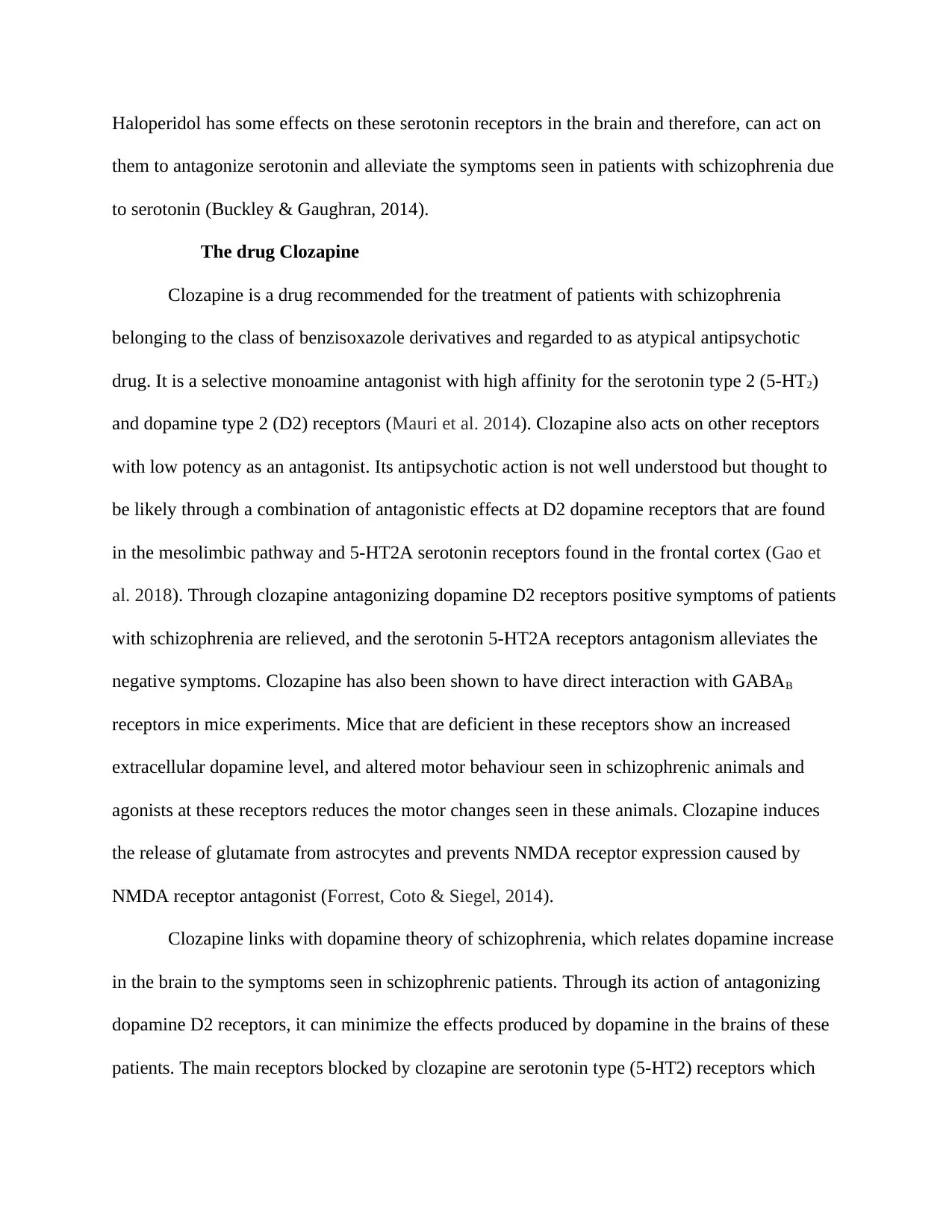
Haloperidol has some effects on these serotonin receptors in the brain and therefore, can act on
them to antagonize serotonin and alleviate the symptoms seen in patients with schizophrenia due
to serotonin (Buckley & Gaughran, 2014).
The drug Clozapine
Clozapine is a drug recommended for the treatment of patients with schizophrenia
belonging to the class of benzisoxazole derivatives and regarded to as atypical antipsychotic
drug. It is a selective monoamine antagonist with high affinity for the serotonin type 2 (5-HT2)
and dopamine type 2 (D2) receptors (Mauri et al. 2014). Clozapine also acts on other receptors
with low potency as an antagonist. Its antipsychotic action is not well understood but thought to
be likely through a combination of antagonistic effects at D2 dopamine receptors that are found
in the mesolimbic pathway and 5-HT2A serotonin receptors found in the frontal cortex (Gao et
al. 2018). Through clozapine antagonizing dopamine D2 receptors positive symptoms of patients
with schizophrenia are relieved, and the serotonin 5-HT2A receptors antagonism alleviates the
negative symptoms. Clozapine has also been shown to have direct interaction with GABAB
receptors in mice experiments. Mice that are deficient in these receptors show an increased
extracellular dopamine level, and altered motor behaviour seen in schizophrenic animals and
agonists at these receptors reduces the motor changes seen in these animals. Clozapine induces
the release of glutamate from astrocytes and prevents NMDA receptor expression caused by
NMDA receptor antagonist (Forrest, Coto & Siegel, 2014).
Clozapine links with dopamine theory of schizophrenia, which relates dopamine increase
in the brain to the symptoms seen in schizophrenic patients. Through its action of antagonizing
dopamine D2 receptors, it can minimize the effects produced by dopamine in the brains of these
patients. The main receptors blocked by clozapine are serotonin type (5-HT2) receptors which
them to antagonize serotonin and alleviate the symptoms seen in patients with schizophrenia due
to serotonin (Buckley & Gaughran, 2014).
The drug Clozapine
Clozapine is a drug recommended for the treatment of patients with schizophrenia
belonging to the class of benzisoxazole derivatives and regarded to as atypical antipsychotic
drug. It is a selective monoamine antagonist with high affinity for the serotonin type 2 (5-HT2)
and dopamine type 2 (D2) receptors (Mauri et al. 2014). Clozapine also acts on other receptors
with low potency as an antagonist. Its antipsychotic action is not well understood but thought to
be likely through a combination of antagonistic effects at D2 dopamine receptors that are found
in the mesolimbic pathway and 5-HT2A serotonin receptors found in the frontal cortex (Gao et
al. 2018). Through clozapine antagonizing dopamine D2 receptors positive symptoms of patients
with schizophrenia are relieved, and the serotonin 5-HT2A receptors antagonism alleviates the
negative symptoms. Clozapine has also been shown to have direct interaction with GABAB
receptors in mice experiments. Mice that are deficient in these receptors show an increased
extracellular dopamine level, and altered motor behaviour seen in schizophrenic animals and
agonists at these receptors reduces the motor changes seen in these animals. Clozapine induces
the release of glutamate from astrocytes and prevents NMDA receptor expression caused by
NMDA receptor antagonist (Forrest, Coto & Siegel, 2014).
Clozapine links with dopamine theory of schizophrenia, which relates dopamine increase
in the brain to the symptoms seen in schizophrenic patients. Through its action of antagonizing
dopamine D2 receptors, it can minimize the effects produced by dopamine in the brains of these
patients. The main receptors blocked by clozapine are serotonin type (5-HT2) receptors which
Paraphrase This Document
Need a fresh take? Get an instant paraphrase of this document with our AI Paraphraser

link this mechanism of action to serotonin theory. Blocking these serotonin receptors helps
minimize the symptoms seen in these patients. Clozapine also links to glutamate theory of
schizophrenia by preventing NMDA receptor expression, thereby decreasing effects of increased
glutamate levels in the brain of patients with schizophrenia (Stansley & Conn, 2018).
Conclusion
The three theories of schizophrenia proposed are not sufficient on their own to explain
the origin and all the symptoms seen in schizophrenic patients. It is difficult to carry out the tests
needed in the brains of patients with the disorder, and this presents an enormous challenge
towards fully understanding schizophrenia. Numerous gaps are seen in the theories proposed
majorly because they are based on trying to understand how drugs developed for other conditions
are associated with schizophrenia. The theories need to be developed in order to fully address the
neurochemical genesis of the disorder though it is a challenge bearing that this is a brain
disorder. Linking the mechanism of action of the drugs to the neurochemical theories helps in
understanding the disorder better and aids in future research to provide newer mitigations that
can help reduce the period taken to see the clinical effects of the drugs. The modern techniques
of imaging being developed are of great help for a better view of the brain to analyze the
disorder.
minimize the symptoms seen in these patients. Clozapine also links to glutamate theory of
schizophrenia by preventing NMDA receptor expression, thereby decreasing effects of increased
glutamate levels in the brain of patients with schizophrenia (Stansley & Conn, 2018).
Conclusion
The three theories of schizophrenia proposed are not sufficient on their own to explain
the origin and all the symptoms seen in schizophrenic patients. It is difficult to carry out the tests
needed in the brains of patients with the disorder, and this presents an enormous challenge
towards fully understanding schizophrenia. Numerous gaps are seen in the theories proposed
majorly because they are based on trying to understand how drugs developed for other conditions
are associated with schizophrenia. The theories need to be developed in order to fully address the
neurochemical genesis of the disorder though it is a challenge bearing that this is a brain
disorder. Linking the mechanism of action of the drugs to the neurochemical theories helps in
understanding the disorder better and aids in future research to provide newer mitigations that
can help reduce the period taken to see the clinical effects of the drugs. The modern techniques
of imaging being developed are of great help for a better view of the brain to analyze the
disorder.

References
Alexander, S. P., Benson, H. E., Faccenda, E., Pawson, A. J., Sharman, J. L., Spedding, M., ... &
CGTP Collaborators. (2013). The concise guide to PHARMACOLOGY 2013/14:
enzymes. British Journal of Pharmacology, 170(8), 1797-1867.
Brandon, N. J., & Sawa, A. (2011). Linking neurodevelopmental and synaptic theories of mental
illness through DISC1. Nature Reviews Neuroscience, 12(12), 707.
Buckley, P. F., & Gaughran, F. (2014). Treatment-refractory Schizophrenia: A clinical
conundrum.
Forrest, A. D., Coto, C. A., & Siegel, S. J. (2014). Animal models of psychosis: current state and
future directions. Current behavioral neuroscience reports, 1(2), 100-116.
Gao, J., Wu, R., Davis, C., & Li, M. (2018). Activation of 5-HT2A receptor disrupts rat maternal
behavior. Neuropharmacology, 128, 96-105.
Gross, G., Wicke, K., & Drescher, K. U. (2013). Dopamine D 3 receptor antagonism—still a
therapeutic option for the treatment of schizophrenia. Naunyn-Schmiedeberg's archives
of pharmacology, 386(2), 155-166.
Alexander, S. P., Benson, H. E., Faccenda, E., Pawson, A. J., Sharman, J. L., Spedding, M., ... &
CGTP Collaborators. (2013). The concise guide to PHARMACOLOGY 2013/14:
enzymes. British Journal of Pharmacology, 170(8), 1797-1867.
Brandon, N. J., & Sawa, A. (2011). Linking neurodevelopmental and synaptic theories of mental
illness through DISC1. Nature Reviews Neuroscience, 12(12), 707.
Buckley, P. F., & Gaughran, F. (2014). Treatment-refractory Schizophrenia: A clinical
conundrum.
Forrest, A. D., Coto, C. A., & Siegel, S. J. (2014). Animal models of psychosis: current state and
future directions. Current behavioral neuroscience reports, 1(2), 100-116.
Gao, J., Wu, R., Davis, C., & Li, M. (2018). Activation of 5-HT2A receptor disrupts rat maternal
behavior. Neuropharmacology, 128, 96-105.
Gross, G., Wicke, K., & Drescher, K. U. (2013). Dopamine D 3 receptor antagonism—still a
therapeutic option for the treatment of schizophrenia. Naunyn-Schmiedeberg's archives
of pharmacology, 386(2), 155-166.
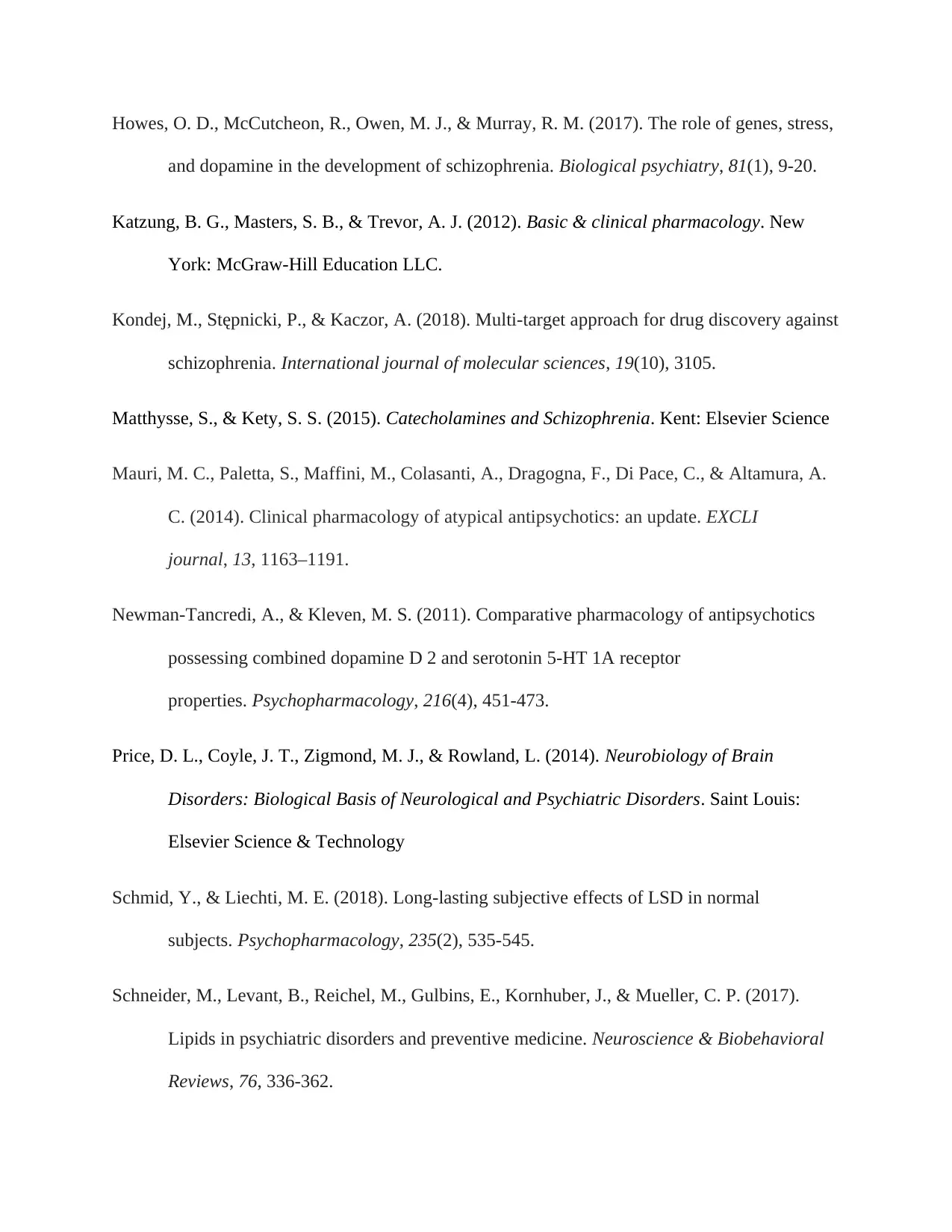
Howes, O. D., McCutcheon, R., Owen, M. J., & Murray, R. M. (2017). The role of genes, stress,
and dopamine in the development of schizophrenia. Biological psychiatry, 81(1), 9-20.
Katzung, B. G., Masters, S. B., & Trevor, A. J. (2012). Basic & clinical pharmacology. New
York: McGraw-Hill Education LLC.
Kondej, M., Stępnicki, P., & Kaczor, A. (2018). Multi-target approach for drug discovery against
schizophrenia. International journal of molecular sciences, 19(10), 3105.
Matthysse, S., & Kety, S. S. (2015). Catecholamines and Schizophrenia. Kent: Elsevier Science
Mauri, M. C., Paletta, S., Maffini, M., Colasanti, A., Dragogna, F., Di Pace, C., & Altamura, A.
C. (2014). Clinical pharmacology of atypical antipsychotics: an update. EXCLI
journal, 13, 1163–1191.
Newman-Tancredi, A., & Kleven, M. S. (2011). Comparative pharmacology of antipsychotics
possessing combined dopamine D 2 and serotonin 5-HT 1A receptor
properties. Psychopharmacology, 216(4), 451-473.
Price, D. L., Coyle, J. T., Zigmond, M. J., & Rowland, L. (2014). Neurobiology of Brain
Disorders: Biological Basis of Neurological and Psychiatric Disorders. Saint Louis:
Elsevier Science & Technology
Schmid, Y., & Liechti, M. E. (2018). Long-lasting subjective effects of LSD in normal
subjects. Psychopharmacology, 235(2), 535-545.
Schneider, M., Levant, B., Reichel, M., Gulbins, E., Kornhuber, J., & Mueller, C. P. (2017).
Lipids in psychiatric disorders and preventive medicine. Neuroscience & Biobehavioral
Reviews, 76, 336-362.
and dopamine in the development of schizophrenia. Biological psychiatry, 81(1), 9-20.
Katzung, B. G., Masters, S. B., & Trevor, A. J. (2012). Basic & clinical pharmacology. New
York: McGraw-Hill Education LLC.
Kondej, M., Stępnicki, P., & Kaczor, A. (2018). Multi-target approach for drug discovery against
schizophrenia. International journal of molecular sciences, 19(10), 3105.
Matthysse, S., & Kety, S. S. (2015). Catecholamines and Schizophrenia. Kent: Elsevier Science
Mauri, M. C., Paletta, S., Maffini, M., Colasanti, A., Dragogna, F., Di Pace, C., & Altamura, A.
C. (2014). Clinical pharmacology of atypical antipsychotics: an update. EXCLI
journal, 13, 1163–1191.
Newman-Tancredi, A., & Kleven, M. S. (2011). Comparative pharmacology of antipsychotics
possessing combined dopamine D 2 and serotonin 5-HT 1A receptor
properties. Psychopharmacology, 216(4), 451-473.
Price, D. L., Coyle, J. T., Zigmond, M. J., & Rowland, L. (2014). Neurobiology of Brain
Disorders: Biological Basis of Neurological and Psychiatric Disorders. Saint Louis:
Elsevier Science & Technology
Schmid, Y., & Liechti, M. E. (2018). Long-lasting subjective effects of LSD in normal
subjects. Psychopharmacology, 235(2), 535-545.
Schneider, M., Levant, B., Reichel, M., Gulbins, E., Kornhuber, J., & Mueller, C. P. (2017).
Lipids in psychiatric disorders and preventive medicine. Neuroscience & Biobehavioral
Reviews, 76, 336-362.
Secure Best Marks with AI Grader
Need help grading? Try our AI Grader for instant feedback on your assignments.
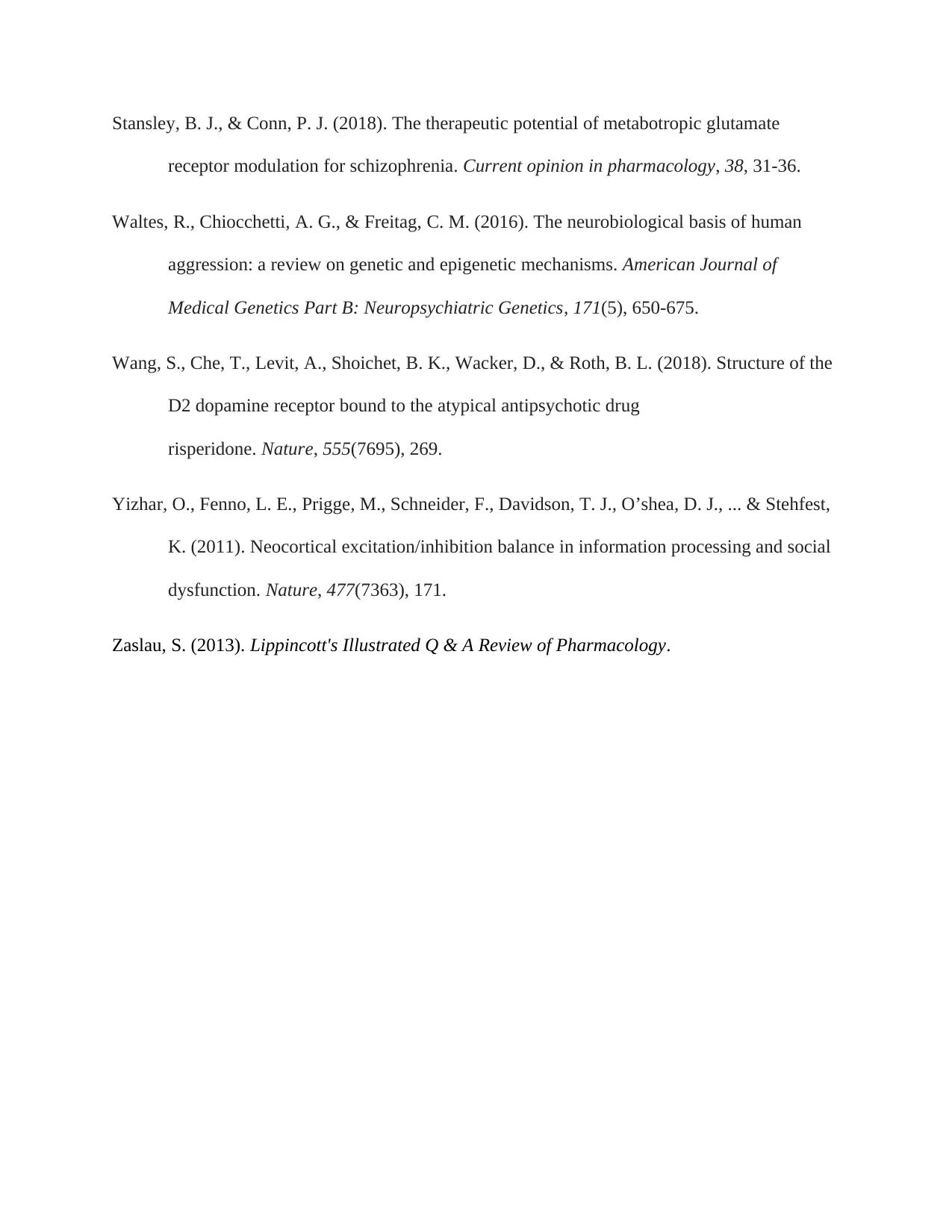
Stansley, B. J., & Conn, P. J. (2018). The therapeutic potential of metabotropic glutamate
receptor modulation for schizophrenia. Current opinion in pharmacology, 38, 31-36.
Waltes, R., Chiocchetti, A. G., & Freitag, C. M. (2016). The neurobiological basis of human
aggression: a review on genetic and epigenetic mechanisms. American Journal of
Medical Genetics Part B: Neuropsychiatric Genetics, 171(5), 650-675.
Wang, S., Che, T., Levit, A., Shoichet, B. K., Wacker, D., & Roth, B. L. (2018). Structure of the
D2 dopamine receptor bound to the atypical antipsychotic drug
risperidone. Nature, 555(7695), 269.
Yizhar, O., Fenno, L. E., Prigge, M., Schneider, F., Davidson, T. J., O’shea, D. J., ... & Stehfest,
K. (2011). Neocortical excitation/inhibition balance in information processing and social
dysfunction. Nature, 477(7363), 171.
Zaslau, S. (2013). Lippincott's Illustrated Q & A Review of Pharmacology.
receptor modulation for schizophrenia. Current opinion in pharmacology, 38, 31-36.
Waltes, R., Chiocchetti, A. G., & Freitag, C. M. (2016). The neurobiological basis of human
aggression: a review on genetic and epigenetic mechanisms. American Journal of
Medical Genetics Part B: Neuropsychiatric Genetics, 171(5), 650-675.
Wang, S., Che, T., Levit, A., Shoichet, B. K., Wacker, D., & Roth, B. L. (2018). Structure of the
D2 dopamine receptor bound to the atypical antipsychotic drug
risperidone. Nature, 555(7695), 269.
Yizhar, O., Fenno, L. E., Prigge, M., Schneider, F., Davidson, T. J., O’shea, D. J., ... & Stehfest,
K. (2011). Neocortical excitation/inhibition balance in information processing and social
dysfunction. Nature, 477(7363), 171.
Zaslau, S. (2013). Lippincott's Illustrated Q & A Review of Pharmacology.
1 out of 11
![[object Object]](/_next/static/media/star-bottom.7253800d.svg)





